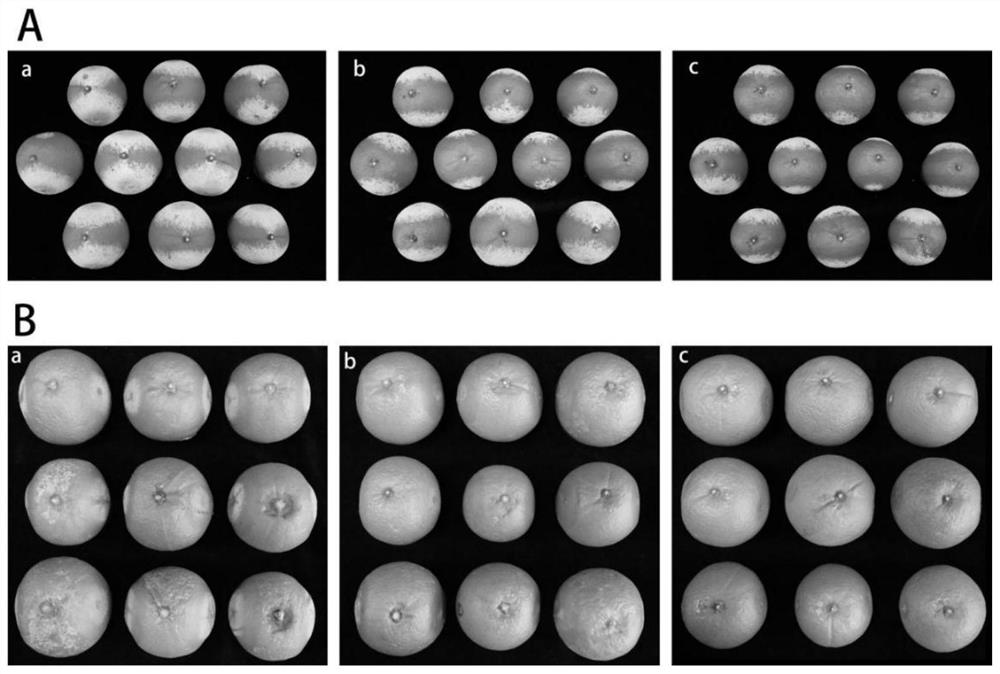Application of dimethyl dicarbonate in preparation of postharvest citrus preservative
A technology of dimethyl dicarbonate and a preservative is applied in the application field of preparing the main postharvest disease preservatives and preservatives for citrus, can solve the problems of inhibitory effect and no relevant reports on storage and preservation, and achieves inhibition of citrus Green mold and sour rot, the effect of improving the ability to keep fresh and enhancing the defense ability
- Summary
- Abstract
- Description
- Claims
- Application Information
AI Technical Summary
Problems solved by technology
Method used
Image
Examples
Embodiment 1
[0042] Inhibition experiments of different concentrations of dimethyl dicarbonate on P.digitatum and G.citri-candidum:
[0043] In the present embodiment, in the 96-well plate experiment, different concentrations were used to measure the mycelial growth inhibition of Penicillium citrus digitatum and Sour rot fungus. 4 CFU / mL, and add dimethyl dicarbonate solution (diluted with absolute ethanol 1:4 to 312.5g / L) to make the final concentration 0.032g / L, 0.062g / L, 0.125g / L, 0.25 g / L, 0.5g / L, 1g / L, with absolute ethanol as the control. Add 200μL to a 96-well plate and repeat three times. Use 5% PDB to prepare Sour rot fungus spore suspension 1×10 5 CFU / mL, and add dimethyl dicarbonate solution (diluted with absolute ethanol 1:4 to 312.5g / L) to make the final concentration 0.062g / L, 0.125g / L, 0.25g / L, 0.375 g / L, 0.5g / L, 0.625g / L, with absolute ethanol as the control. Add 200μL to a 96-well plate and repeat three times.
[0044] 2. Place the 96-well plate of Penicillium digitat...
Embodiment 2
[0049] The application of low-concentration dimethyl dicarbonate in the preparation and control of postharvest citrus green mold is as follows:
[0050] 1. Select 30 ripe sweet orange fruits with the same size and no mechanical damage, soak in 2% sodium hypochlorite solution for 2 minutes, rinse twice with water, and air-dry at room temperature;
[0051] 2. Mix dimethyl dicarbonate and absolute ethanol at a volume ratio of 1:4 to prepare dimethyl dicarbonate mother liquor (concentration: 312.5g / L), take dimethyl dicarbonate mother liquor in 2L In water, the final concentrations were 1.675g / L and 6.7g / L respectively;
[0052] 3. Divide 30 fruits into 3 groups, with 10 fruits in each group. The fruits of the first group were immersed in 0.25% absolute ethanol for 1 min, and the fruits of the second group were immersed in 1.675 g / L dimethyl dicarbonate for 1 min; The third group was immersed in 6.7g / L dimethyl dicarbonate for 1min;
[0053] 4. Configure 1×10 with sterile water ...
Embodiment 3
[0063] The application of dimethyl dicarbonate in the preparation and prevention of postharvest citrus sour rot, its application method is:
[0064] 1. Select 27 ripe sweet orange fruits with the same size and no mechanical damage, soak them in 2% sodium hypochlorite solution for 2 minutes, rinse them twice with water, and air-dry them at room temperature;
[0065] 2. Mix DMDC and absolute ethanol at a volume ratio of 1:4 to prepare dimethyl dicarbonate mother liquor (concentration is 312.5g / L), take dimethyl dicarbonate mother liquor in 2L distilled water, and the final concentrations are respectively 1.34g / L and 6.7g / L;
[0066] 3. Divide 27 fruits into 3 groups, 9 fruits in each group. The first group of fruits was immersed in 0.25% absolute ethanol for 1 min, and the second group was immersed in 1.34 g / L dimethyl dicarbonate for 1 min. The third group was immersed in 6.7g / L dimethyl dicarbonate for 1min, and air-dried in an ultra-clean workbench.
[0067] 4. Configure 5×...
PUM
 Login to View More
Login to View More Abstract
Description
Claims
Application Information
 Login to View More
Login to View More - R&D
- Intellectual Property
- Life Sciences
- Materials
- Tech Scout
- Unparalleled Data Quality
- Higher Quality Content
- 60% Fewer Hallucinations
Browse by: Latest US Patents, China's latest patents, Technical Efficacy Thesaurus, Application Domain, Technology Topic, Popular Technical Reports.
© 2025 PatSnap. All rights reserved.Legal|Privacy policy|Modern Slavery Act Transparency Statement|Sitemap|About US| Contact US: help@patsnap.com



